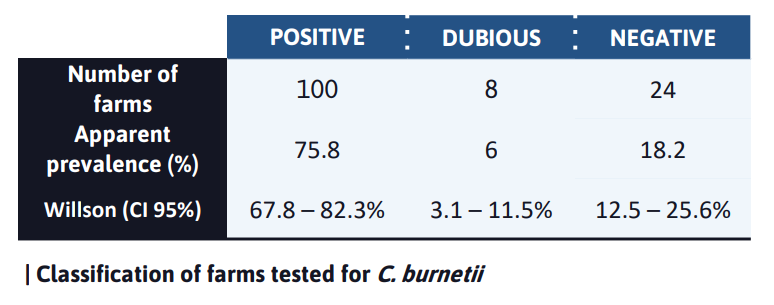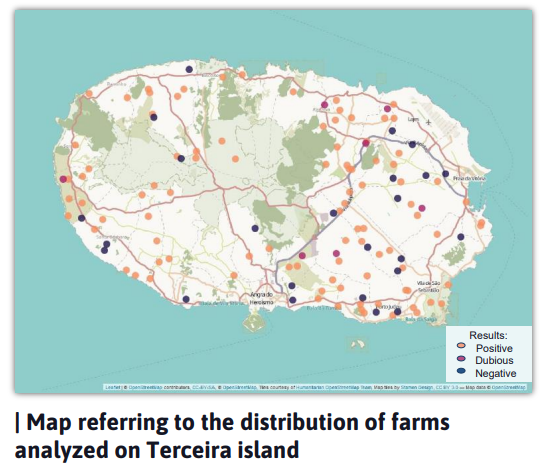Poster
Prevalence and risk factors associated to Coxiella burnetii in Terceira Island dairy farms
Authors
Rodrigo Rodrigues (Faculty of Veterinary Medicine, Technical University of Lisbon, Lisbon, Portugal); João Fagundes (UNICOL, Terceira Island, Portugal); Ricardo Bexiga (Faculty of Veterinary Medicine, Technical University of Lisbon, Lisbon, Portugal); Damien Achard (Ceva Santé Animale, Libourne, France); José Cardoso (Ceva Saúde Animal, Lisbon, Portugal)
Publication information
World Buiatric Congress 2022
OBJECTIVES
The dynamics of C. burnetii infection in ruminant herds in Portugal is not well understood. Recently, a study reported that C. burnetii was endemic in dairy livestock in Central Portugal (Anastácio et al., 2016) but the epidemiologic situation of Azores islands, one of the main ontributor to the dairy industry in Portugal is currently unknown. The main goal of this study was to determine the prevalence of antibodies against Coxiella burnetii in cattle from dairy farms in Terceira Island, Azores – Portugal, and investigate the potential risk factors, which could contribute to the infection and dissemination of Q fever in the herd.
MATERIALS AND METHODS
The survey was conducted from January 2018 to March 2018 in Terceira Island, Azores, Portugal. At the date of sample collection, no dairy farm had started vaccination for Q fever. Thus, it was possible to assume that the antibodies present were the result of contact with the agent. The survey relied on the detection of milk antibody in bulk tank milk (BTM) as BTM has been shown to be a suitable sample to screen for C. burnetii infection on lactating animals and the milk antibody analysis by ELISA testing is also a reliable tool to provide information about the exposure to C. burnetii.
Bulk tank milk (BTM) samples were obtained from 132 randomly selected dairy farms and analyzed using a commercial ELISA kit (ID Screen® Q fever indirect multi-species ELISA, IDVet Genetics). Sample size was representative of the existent 544 dairy farms in the island (CI 95%, margin of error of 7.5%). During February and March of 2018, a questionnaire was conducted to collect information concerning characterization of the farm, herd health and farm management from the selected farms. Statistical analysis was performed using R® program and Pearson’s Chi-square tests were performed for the variables that were investigated as potential risk factors.
RESULTS


The apparent prevalence of C. burnetii was 75.8% (CI 95%: 67.8-82.3). The proportion of negative and inconclusive herds was 18.2% (24/132) and 6% (8/132) respectively. The results demonstrated a uniform distribution of positive cases in both counties of Terceira Island. In the univariate analyses, three factors were identified as presenting a significant association with the presence of anti- C. burnetii antibodies in BTM, namely the size of the herd (>50 animals), the contact of the animals with cattle from other farms and the direct interaction of the animals with dogs or cats (P <0.05).
CONCLUSIONS
This study is the first to report the prevalence of C. burnetii and associated risk factors in Terceira island dairy farms. Our data provide evidence of a high prevalence of Q fever in Azores and contact with cattle from neighboring farms seems to be a relevant risk factor for the presence of antibodies against this agent. The problem of Q Fever should be seen from a global perspective of raising awareness among veterinarians and producers so that the most appropriate control strategies, such as vaccination and proper management conditions, can be established.
Don´t hesitate to read the rest of our publicatons and improve your knowledge about ruminats and their health!
Publication file:



